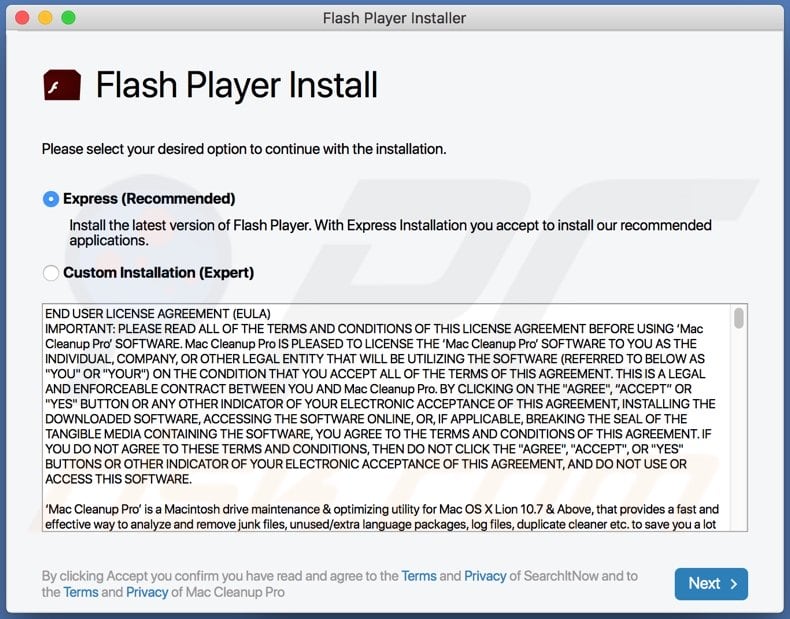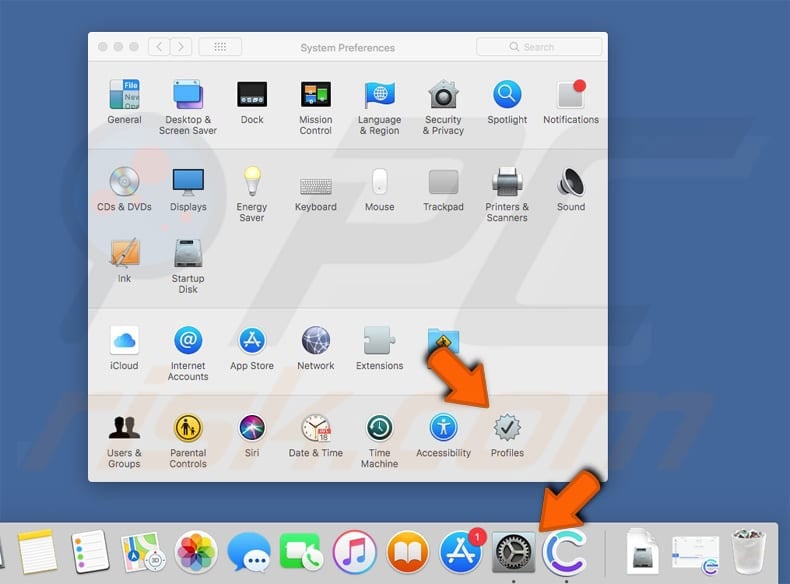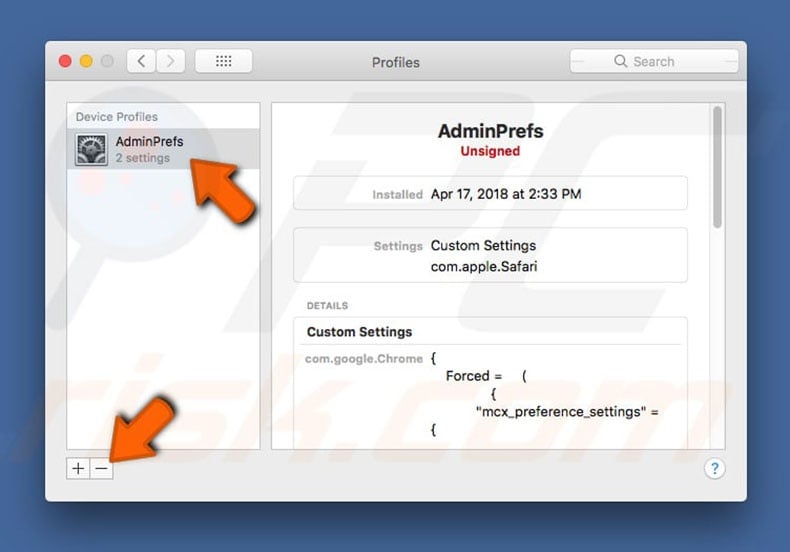Get free scan and check if your device is infected.
Remove it nowTo use full-featured product, you have to purchase a license for Combo Cleaner. Seven days free trial available. Combo Cleaner is owned and operated by RCS LT, the parent company of PCRisk.com.
What is TotalLetterSearch?
TotalLetterSearch is an unwanted application classified as adware. This adware is a part of a group of adware-type applications called AdLoad. Adware is simply designed to display various advertisements, however, this particular app also promotes the address of a fake search engine.
In this way, TotalLetterSearch functions both as adware and a browser hijacker. Note that it might also track and record information.
Users often download and install adware-type apps inadvertently. Research shows that, to trick people into installing TotalLetterSearch, developers use a fake Adobe Flash Player installer. This type of installer can also be used to proliferate Trojans, ransomware and other malware.

Adware is a type of software that displays unwanted, intrusive advertisements. Programs of this type usually feed users with various coupons, pop-ups, surveys, banners and other ads. These open untrusted web pages or cause download/installation of other unwanted, even malicious programs (but only when people click them).
TotalLetterSearch operates not only as adware, but also as a browser hijacker. Therefore, it changes browser settings. In most cases, these apps assign the URL of a fake search engine as the default search engine, homepage, and new tab.
In this way, they promote fake search engines by forcing users to visit their associated addresses when they open a browser, new tab or enter search queries into the URL bar. Note that these search engines are fake, since they do not generate unique results (or they generate misleading information).
Typically, users cannot remove these bogus addresses from the aforementioned settings unless they uninstall the browser hijacker. Furthermore, TotalLetterSearch might record user-system information. Apps of this type tend to target IP addresses, geolocations, entered search queries, URLs of visited pages, etc.
Sometimes they are capable of accessing personal, sensitive information. The data might be sold to third parties (potentially, cyber criminals) or misused in other ways. As mentioned, people tend to download and install adware and other PUAs inadvertently.
TotalLetterSearch is installed rather than Adobe Flash Player through a fake installer. These installers are used to spread malware such as ransomware, Trojan-type programs and other malicious software, which can lead to data/financial loss, serious privacy issues, and other problems.
| Name | Ads by TotalLetterSearch |
| Threat Type | Adware, Mac malware, Mac virus. |
| Detection Names | Avast (MacOS:Adload-AD [Trj]), AVG (MacOS:Adload-AD [Trj]), ESET-NOD32 (A Variant Of OSX/TrojanDownloader.Adload.AE), Kaspersky (Not-a-virus:HEUR:AdWare.OSX.Cimpli.k), Full List (VirusTotal) |
| Symptoms | Your Mac becomes slower than normal, you see unwanted pop-up ads, you are redirected to dubious websites. |
| Distribution methods | Deceptive pop-up ads, free software installers (bundling), fake Flash Player installers, torrent file downloads. |
| Damage | Internet browser tracking (potential privacy issues), display of unwanted ads, redirects to dubious websites, loss of private information. |
| Malware Removal (Windows) |
To eliminate possible malware infections, scan your computer with legitimate antivirus software. Our security researchers recommend using Combo Cleaner. Download Combo CleanerTo use full-featured product, you have to purchase a license for Combo Cleaner. 7 days free trial available. Combo Cleaner is owned and operated by RCS LT, the parent company of PCRisk.com. |
Most adware-type applications generate revenue for the developers by deploying online advertisements. They might be advertised as "useful", however, few deliver any value. On the contrary, adware-type applications can cause serious problems and should never be downloaded or installed.
Some examples of other apps of this type include UltraSearchApp, ActiveTrack and UpgradeAssist.
How did TotalLetterSearch install on my computer?
TotalLetterSearch can be installed through a fake installer, which is disguised as a Adobe Flash Player installer. Dubious apps are also distributed using a deceptive marketing method called "bundling". In summary, developers include unwanted apps into the download/installation set-ups of other (usually free) programs.
They hide related information in "Custom", "Advanced" and other settings. Many users download and install their programs without changing the default settings, thereby inadvertently agreeing with offers to download and install any additionally-included software.
Unwanted downloads and installation can also be caused by clicking deceptive ads capable of executing certain scripts.
How to avoid installation of unwanted applications
Unwanted downloads and installations can be avoided by downloading programs and files from official, trustworthy websites (and via direct links). It is not safe to download or install them through third party downloaders, installers, Peer to-Peer networks (e.g., torrent clients, eMule), dubious websites or other similar channels.
Check all download and installation settings (such as "Advanced", "Custom") and decline any offers to download or install unwanted apps. Do not click advertisements that are displayed on untrusted websites, since they can open other pages of this kind or download and install unwanted software.
Remove any unwanted, suspicious extensions, plug-ins and add-ons already installed on the browser immediately. The same applies to programs of this kind that are installed on the operating system. If your computer is already infected with TotalLetterSearch, we recommend running a scan with Combo Cleaner Antivirus for Windows to automatically eliminate this adware.
Files related to TotalLetterSearch adware that need to be removed:
- ~/Library/Application Support/com.TotalLetterSearch/TotalLetterSearch
- ~/Library/Application Support/com.TotalLetterSearchDaemon/TotalLetterSearch
- ~/Library/LaunchAgents/com.TotalLetterSearch.plist
- ~/Library/LaunchDaemons/com.TotalLetterSearch.plist
IMPORTANT NOTE! Rogue setups/apps that promote TotalLetterSearch adware are designed to create a new device profile. Therefore, before taking any further removal steps, perform these actions:
1) Click the "Preferences" icon in the menu bar and select "Profiles".

2) Select the "TotalLetterSearch" profile and delete it.

3) Perform a full system scan with Combo Cleaner anti-virus suite.
After performing these actions, you can proceed with further removal steps for this adware.
Instant automatic malware removal:
Manual threat removal might be a lengthy and complicated process that requires advanced IT skills. Combo Cleaner is a professional automatic malware removal tool that is recommended to get rid of malware. Download it by clicking the button below:
DOWNLOAD Combo CleanerBy downloading any software listed on this website you agree to our Privacy Policy and Terms of Use. To use full-featured product, you have to purchase a license for Combo Cleaner. 7 days free trial available. Combo Cleaner is owned and operated by RCS LT, the parent company of PCRisk.com.
Quick menu:
- What is TotalLetterSearch?
- STEP 1. Remove TotalLetterSearch related files and folders from OSX.
- STEP 2. Remove TotalLetterSearch ads from Safari.
- STEP 3. Remove TotalLetterSearch adware from Google Chrome.
- STEP 4. Remove TotalLetterSearch ads from Mozilla Firefox.
Video showing how to remove adware and browser hijackers from a Mac computer:
TotalLetterSearch adware removal:
Remove TotalLetterSearch-related potentially unwanted applications from your "Applications" folder:

Click the Finder icon. In the Finder window, select "Applications". In the applications folder, look for "MPlayerX", "NicePlayer", or other suspicious applications and drag them to the Trash. After removing the potentially unwanted application(s) that cause online ads, scan your Mac for any remaining unwanted components.
DOWNLOAD remover for malware infections
Combo Cleaner checks if your computer is infected with malware. To use full-featured product, you have to purchase a license for Combo Cleaner. 7 days free trial available. Combo Cleaner is owned and operated by RCS LT, the parent company of PCRisk.com.
Remove adware-related files and folders

Click the Finder icon, from the menu bar. Choose Go, and click Go to Folder...
 Check for adware generated files in the /Library/LaunchAgents/ folder:
Check for adware generated files in the /Library/LaunchAgents/ folder:

In the Go to Folder... bar, type: /Library/LaunchAgents/

In the "LaunchAgents" folder, look for any recently-added suspicious files and move them to the Trash. Examples of files generated by adware - "installmac.AppRemoval.plist", "myppes.download.plist", "mykotlerino.ltvbit.plist", "kuklorest.update.plist", etc. Adware commonly installs several files with the exact same string.
 Check for adware generated files in the ~/Library/Application Support/ folder:
Check for adware generated files in the ~/Library/Application Support/ folder:

In the Go to Folder... bar, type: ~/Library/Application Support/

In the "Application Support" folder, look for any recently-added suspicious folders. For example, "MplayerX" or "NicePlayer", and move these folders to the Trash.
 Check for adware generated files in the ~/Library/LaunchAgents/ folder:
Check for adware generated files in the ~/Library/LaunchAgents/ folder:

In the Go to Folder... bar, type: ~/Library/LaunchAgents/

In the "LaunchAgents" folder, look for any recently-added suspicious files and move them to the Trash. Examples of files generated by adware - "installmac.AppRemoval.plist", "myppes.download.plist", "mykotlerino.ltvbit.plist", "kuklorest.update.plist", etc. Adware commonly installs several files with the exact same string.
 Check for adware generated files in the /Library/LaunchDaemons/ folder:
Check for adware generated files in the /Library/LaunchDaemons/ folder:

In the "Go to Folder..." bar, type: /Library/LaunchDaemons/

In the "LaunchDaemons" folder, look for recently-added suspicious files. For example "com.aoudad.net-preferences.plist", "com.myppes.net-preferences.plist", "com.kuklorest.net-preferences.plist", "com.avickUpd.plist", etc., and move them to the Trash.
 Scan your Mac with Combo Cleaner:
Scan your Mac with Combo Cleaner:
If you have followed all the steps correctly, your Mac should be clean of infections. To ensure your system is not infected, run a scan with Combo Cleaner Antivirus. Download it HERE. After downloading the file, double click combocleaner.dmg installer. In the opened window, drag and drop the Combo Cleaner icon on top of the Applications icon. Now open your launchpad and click on the Combo Cleaner icon. Wait until Combo Cleaner updates its virus definition database and click the "Start Combo Scan" button.

Combo Cleaner will scan your Mac for malware infections. If the antivirus scan displays "no threats found" - this means that you can continue with the removal guide; otherwise, it's recommended to remove any found infections before continuing.

After removing files and folders generated by the adware, continue to remove rogue extensions from your Internet browsers.
Remove malicious extensions from Internet browsers
 Remove malicious Safari extensions:
Remove malicious Safari extensions:

Open the Safari browser, from the menu bar, select "Safari" and click "Preferences...".

In the preferences window, select "Extensions" and look for any recently-installed suspicious extensions. When located, click the "Uninstall" button next to it/them. Note that you can safely uninstall all extensions from your Safari browser - none are crucial for regular browser operation.
- If you continue to have problems with browser redirects and unwanted advertisements - Reset Safari.
 Remove malicious extensions from Google Chrome:
Remove malicious extensions from Google Chrome:

Click the Chrome menu icon ![]() (at the top right corner of Google Chrome), select "More Tools" and click "Extensions". Locate all recently-installed suspicious extensions, select these entries and click "Remove".
(at the top right corner of Google Chrome), select "More Tools" and click "Extensions". Locate all recently-installed suspicious extensions, select these entries and click "Remove".

- If you continue to have problems with browser redirects and unwanted advertisements - Reset Google Chrome.
 Remove malicious extensions from Mozilla Firefox:
Remove malicious extensions from Mozilla Firefox:

Click the Firefox menu ![]() (at the top right corner of the main window) and select "Add-ons and themes". Click "Extensions", in the opened window locate all recently-installed suspicious extensions, click on the three dots and then click "Remove".
(at the top right corner of the main window) and select "Add-ons and themes". Click "Extensions", in the opened window locate all recently-installed suspicious extensions, click on the three dots and then click "Remove".

- If you continue to have problems with browser redirects and unwanted advertisements - Reset Mozilla Firefox.
Frequently Asked Questions (FAQ)
What harm can adware cause?
Adware can disrupt user experience, slow down system performance, compromise privacy by tracking user behavior, and potentially lead to security risks through exposure to malicious ads or links.
What does adware do?
Software of this type feeds users with intrusive advertisements. Additionally, it can gather various data and operate as a browser hijacker.
How do adware developers generate revenue?
Adware developers typically generate revenue through the display of intrusive advertisements, earning money based on ad clicks, impressions, or through affiliate marketing programs.
Will Combo Cleaner remove TotalLetterSearch adware?
Combo Cleaner will scan your computer and remove all installed adware-type applications. It is important to know that manual removal may not be foolproof, as remnants of files could persist within the system, even after uninstallation. Even if the primary software is deleted, some of its components may still linger and remain operational.
Share:

Tomas Meskauskas
Expert security researcher, professional malware analyst
I am passionate about computer security and technology. I have an experience of over 10 years working in various companies related to computer technical issue solving and Internet security. I have been working as an author and editor for pcrisk.com since 2010. Follow me on Twitter and LinkedIn to stay informed about the latest online security threats.
PCrisk security portal is brought by a company RCS LT.
Joined forces of security researchers help educate computer users about the latest online security threats. More information about the company RCS LT.
Our malware removal guides are free. However, if you want to support us you can send us a donation.
DonatePCrisk security portal is brought by a company RCS LT.
Joined forces of security researchers help educate computer users about the latest online security threats. More information about the company RCS LT.
Our malware removal guides are free. However, if you want to support us you can send us a donation.
Donate
▼ Show Discussion